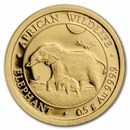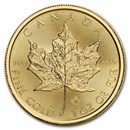Currently Out of Stock
- Product Details
- Specifications
- History
- Sell Gold to Us
Coin Highlights:
- Contains .25 oz of .9999 fine gold.
- Housed in protective packaging.
- Obverse: Displays the effigy of Her Majesty Queen Elizabeth II, along with the face value of 100 pounds.
- Reverse: Features a majestic beast from the Queen's heraldry.
- Sovereign coin backed by the British government.
Add several of these slightly off-quality items to your cart today!
Condition and design on these coins will be of our choosing and may or may not vary, determined by stock on hand. Items may also contain spots, abrasions or gilding.
At the coronation of Her Majesty The Queen, ten heraldic beasts stood guard. The Queen’s Beasts, sculpted by James Woodford RA for the coronation ceremony held in Westminster Abbey in 1953, stand six feet tall. The heraldic creatures symbolized the various strands of royal ancestry brought together in a young woman about to be crowned queen. Each proud beast, used as a heraldic badge by generations that went before her, was inspired by the King’s Beasts of Henry VIII that still line the bridge over the moat at his Hampton Court Palace.
Today, The Queen’s Beasts can be found at the Canadian Museum of History in Quebec, while Portland stone replicas, also carved by James Woodford, watch over Kew Gardens in the United Kingdom. But these mythical, ancient creatures – lions, griffin, falcon, bull, yale, greyhound, dragon, unicorn and horse – have gone on to inspire the highly-praised new talent, Royal Mint Coin Designer Jody Clark.
The Lion of England Queen's Beast is the crowned golden lion of England which has been one of the supporters of the Royal Arms since the accession of James I in 1603. It is supporting a shield showing the Arms of the United Kingdom as they have been since Queen Victoria came to the throne in 1837. In the first and last quarters of the shield are the lions of England. The lion and treasure of Scotland appear in the second, and the harp of Ireland is in the third.
The Barbary lion is a national animal of England. Lion was the nickname of England's medieval warrior rulers with a reputation for bravery, such as Richard I of England, known as Richard the Lionheart. Lions are frequently depicted in English heraldry, either as a device on shields themselves, or as supporters. They also appear in sculpture, and sites of national importance, such as Trafalgar Square. The lion is used as a symbol of English sporting teams, such as the England national cricket team.
Product Specifications
- Product ID: 116223
- Year: Random
- Grade: Brilliant Unc
- Grade Service: None
- Denomination: 25 Pounds
- Mint Mark: Not Shown
- Metal Content: 0.25 troy oz
- Purity: .9999
- Diameter: 22 mm
One of the oldest institutions in the world, the Royal Mint began producing coins for England, and eventually Great Britain, more than 1,100 years ago. The mint also produces and exports coins for other countries, as well as military medals, and other products for the British government. The Royal Mint has been witness to the legendary kings and queens, political upheavals, social and governmental progress, and scientific and technological breakthroughs.
The minting of coins began in England around the end of the second century B.C. Around A.D. 650, coins were made by craftsmen called “moneyers” in London. In 886, during the reign of Alfred the Great, the London Mint was designated to be a single institution, though there were many other mints in operation around this time. In 1279 the London Mint was moved to the Tower of London where it remained for the next 500 years. Famed physicist Sir Isaac Newton was the Warden of the Mint in 1696 and as such was responsible for investigating cases of counterfeiting. Three years later he was made Master of the Mint, until his death in 1727, and was responsible for moving England from the Silver standard to the Gold standard in 1717.
The Royal Mint had outgrown its home in the Tower of London so during the 18th century the rickety wooden shacks the mint occupied were rebuilt to accommodate mechanized and rolling mills and coining presses and provide more space. Soon, however, the mint outgrew this new location and in 1809, the mint moved from the Tower of London to an adjacent site in East Smithfield called Tower Hill. By 1899, the Royal Mint was striking 100 million coins a year.
In 1967 it was announced that mint would move from its location at Tower Hill to Llantrisant, Wales, following Parliament’s decision to decimalize currency and in 1968 the first coins were officially struck by Her Majesty Queen Elizabeth II at the new location in Wales. In 1986, the Royal Mint celebrated 11 centuries of continuous minting. In 2009, the Royal Mint was vested into a government-owned company to provide greater operating and commercial freedom.
One unique aspect of the Royal Mint is a procedure known as the Trial of the Pyx, dates back to 1282 and ensures newly-minted coins meet required government standards. The trials have been held once a each year since their inception and have changed very little over time. These trials are presided over by a judge with a jury of expert assayers and were held at the Palace of Westminster before they were moved to the modern-day site at the Hall of the Worshipful Company of Goldsmiths. The ceremony was so named after the boxwood chest in which coins were placed for presentation to the jury.
Please call our Purchasing team at (800) 514-6318 to speak to one of our representatives or learn more about How to Sell Gold to APMEX.
Not yet rated. Be the first to Write a Review

We provide all of our customers with a refund, return and / or exchange on everything we sell including all bullion and certified coins. If for any reason, you have a problem, please feel free to call us. We will always do our best to accommodate you.




























